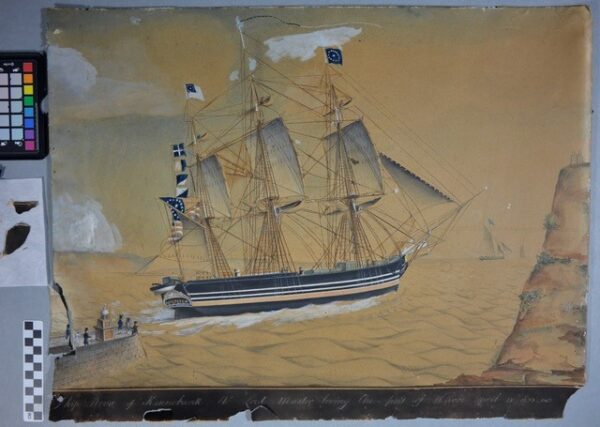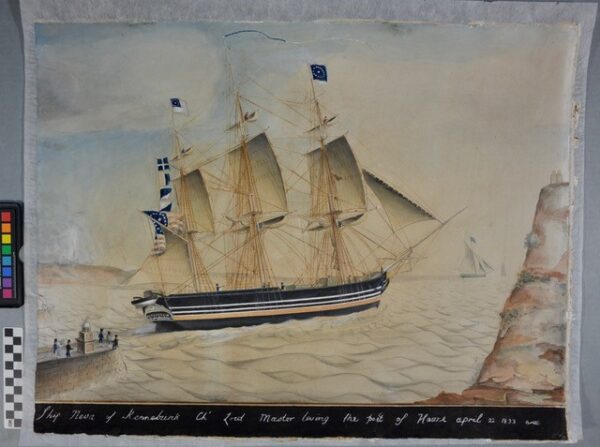The Ship “Neva” Painting Returns Home!
The Brick Store Museum preserves over 55,000 objects and archives relating to the history, art and cultures of Kennebunk and the surrounding communities. Nearly a year ago (March 2024), the Museum hosted a “March Madness” competition, during which museum visitors voted for their “favorite” piece of art from the Museum’s list of conservation projects.
In April 2024, the Museum announced the winner of the vote: a painting of the Kennebunk-built ship Neva, painted in watercolor on paper nearly 200 years ago.
History:
The ship Neva was the first vessel to be launched by William Lord, of Kennebunk, in 1832. The contract for building the ship went to George W. Bourne and his partner of Henry Kingsbury, at the shipyard located behind what is now known as the Wedding Cake House. The vessel was 80 feet long at the keel, 18 feet deep, and about 25 feet wide. In the painting, the Neva is seen leaving the port at Le Havre, France, in 1833. Details include several people waving at the ship from a dock, with another ship in port in the distance.
Conservation work:
Art conservation often costs thousands of dollars because of how specialized the work is. A Maine-based conservator worked on the Neva portrait for nearly seven months due to the lengthy repairs and conservation to its paper backing and paint loss. This work was made possible by generous donations from interested community members through the Museum’s Barry-Bodman Fund. In December 2024, the ship painting was returned to the Museum completely conserved and ready to be viewed by the public. The work included a report on the repairs undertaken:
Report of conservation treatment of one watercolor, gouache and ink on thin wove paper, portrait of Ship Neva of Kennebunk Ch. Lord Master leaving the port of Havre April 22 1833, by an unidentified artist. Painted portion of sheet: 19” x 24.5”
1. The watercolor sheet was removed from its backmount, with steam, poultices, and tools.
2. Heavy gouache applications were consolidated with local applications with small brush.
3. Accretions were reduced with scalpels and spatulas.
4. The painting was float-bathed on several changes of filtered water, deacidified / alkalized with aqueous magnesium bicarbonate, and air-dried. Aqueous work was done on absorbent platform supports.
5. Stains and discoloration will be reduced to the greatest extent safely possible, with light radiation.
6. The watercolor was float-rinsed on a series of filtered water baths, deacidified / alkalized again, and air-dried.
7. Tears were mended on the verso with Japanese tissue and wheat starch paste.
8. The mended watercolor was given a reinforcing and strengthening lining of thin, long-fibred, and stable Japanese paper, adhered with wheat starch paste. The lined artwork was air-dried. Lining paper margins were trimmed to accommodate matting hinges and ease in over-matting.
9. The watercolor painting was relaxed with in a humidity chamber and flattened between blotters and under weighted glass.
10. Losses, tear edges, scrapes, cuts, gouges and pulp fills were toned or inpainted to blend, using archival colorants.
11. The watercolor was hinged with Beva 371 film at the outer edge of the top lining extension to an acid-free backmat. The lower lining extension is protected with a strip of archival, inert polyester film (Mylar-D).
When you can see it:
The work will be on special exhibit for the public to view starting February 1, 2025.


